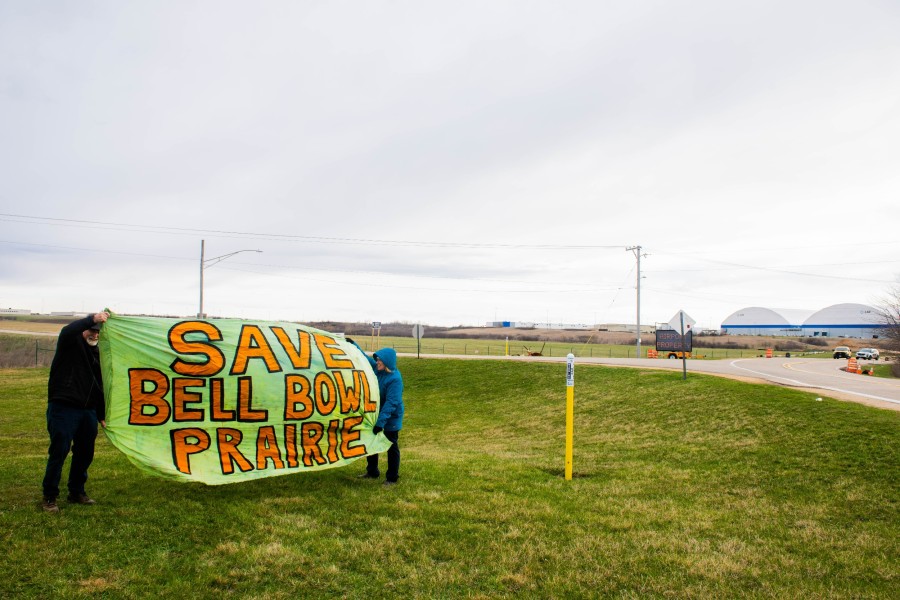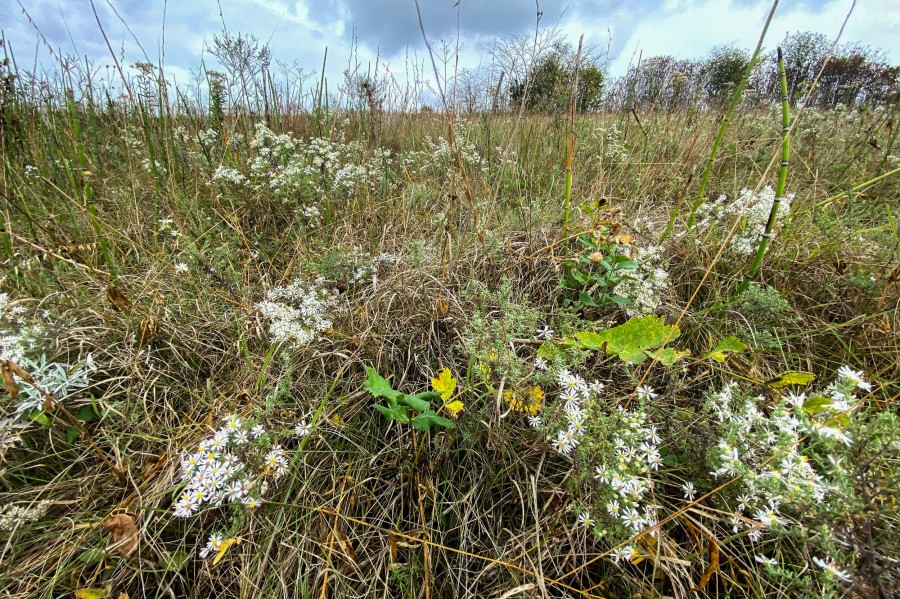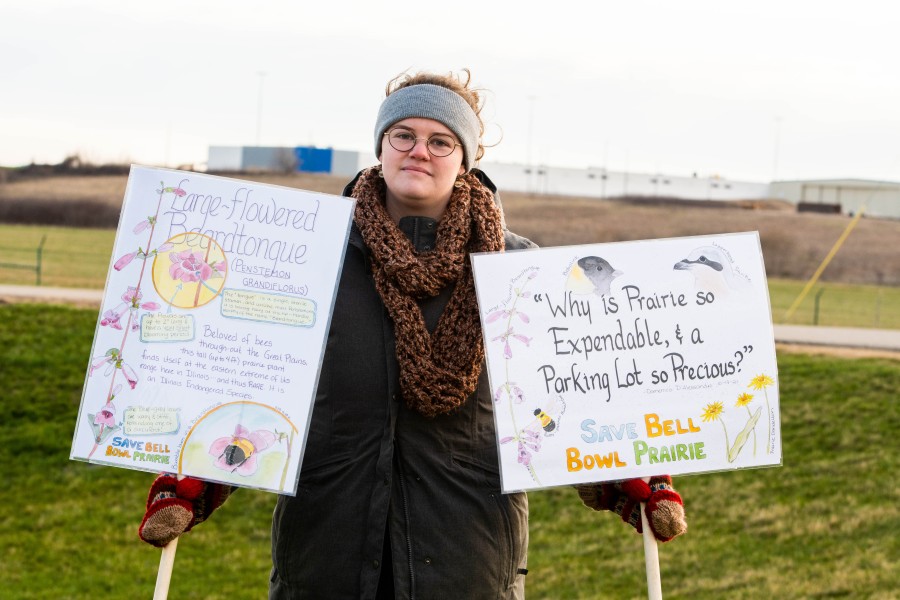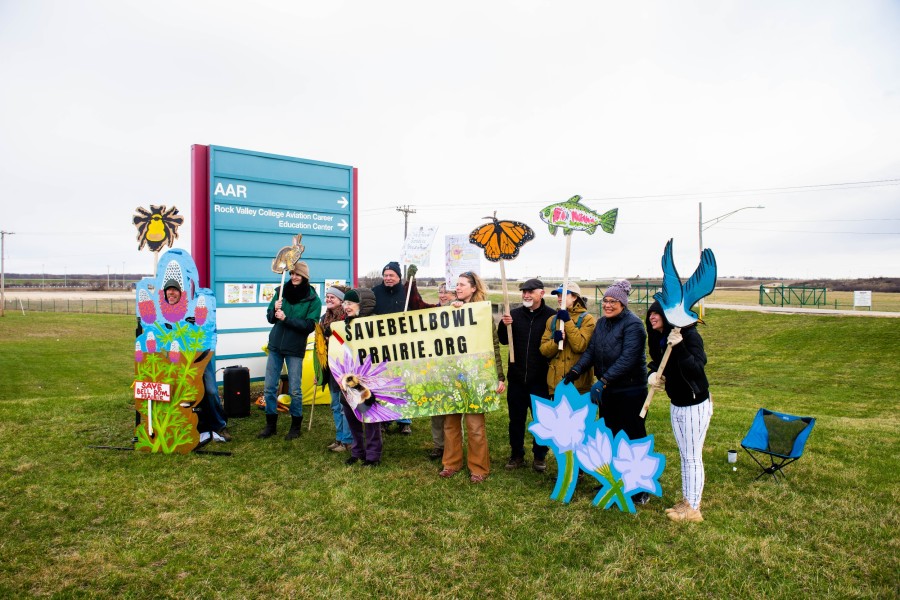
How a tiny bee became a big problem for an Amazon-fueled expansion in Illinois
The Chicago Rockford International Airport wants to grow. Standing in its way is an odd slice of remnant prairie, home to the rusty patched bumblebee.
By Zachary NauthDriving past a favorite birdwatching destination at Bell Bowl Prairie last summer, Dan Williams spotted a big, yellow Caterpillar tractor where wild plum once had grown. Two rows of red-flag stakes ran right through the middle of the prairie, a portable electric billboard flashed a road closure message and fresh topsoil was bared where plants had been peeled off.
“Uh oh,” Williams said to himself. “This is not good.”
It’s an uh-oh moment, again, for the Bell Bowl Prairie in north central Illinois near Rockford, a 21-acre sliver of rocky earth that supports a rare combination of plants, soils, insects and microorganisms. Once considered waste places, only a handful more of unscathed dry gravel prairie remain across the state. The rest has been mostly plowed up, paved over and eradicated in the mad rush of commerce and agriculture across the past 200 years.

Progress too now threatens the Bell Bowl. Its neighbor, the Chicago Rockford International Airport, has been on an expansion boom driven by its role as an Amazon cargo hub fulfilling orders from “one-click” shopping. For a depressed region that was once a rust-belt poster child, the airport, which employs 8,500 people who move $3 billion in international goods annually, is an economic engine that has lifted the region. It has almost nowhere to grow, hemmed in on three sides by two rivers to the south and west, and a railroad to the east.
If not for the discovery of a tiny, endangered bee with a distinctive orange spot known as the rusty patched bumblebee, the prairie – which sits in the middle of the airport – would be bulldozed by now. A lawsuit has stopped construction in its tracks and, with it, a strip of land too steep and gravelly to plow has gone from worthless to priceless in the eyes of its two beholders: Conservationists and officials keen on economic development.

For its defenders, the tiny remnant prairie is a cherished reminder of a less spoiled, almost mythic, past — the land of indigenous tribes, bison and tallgrass plants shimmying in the breeze. For others, the value comes from a scientific understanding that undisturbed prairie, with its complex ecosystem, contains a gene pool of still-hidden lessons for mankind that cannot be recreated or replaced, even by well-meaning prairie restoration projects in Illinois like Midewin and the Nachusa Grasslands.
Each side has something to lose: The airport does not want a lengthy court battle holding up the expansion, and open-land advocates know that current laws favor construction over conservation. Bell Bowl’s steward for almost 50 years, the Natural Land Institute, argues that with minor changes to the design, Rockford can have both airport expansion and preserve a rare prairie remnant.
“We do not want to stop this airport expansion,” Kerry Leigh, the executive director of the land institute, told WBEZ’s Reset in March.
Better yet, one local landscape architect says, redesign the expansion plan to showcase and connect the isolated prairie to nearby open spaces for tourism, recreation and natural resource preservation. There could be a solution in reach, if the two sides start talking.

Bell Bowl has been here before
This is the third time in 100 years that the small and vulnerable Bell Bowl has had to be saved. The first was by a physician, and the second time by his son.
When the United States entered World War I in 1917, the Army bought 6,000 acres of farmland south of Rockford to build a training camp for 56,000 troops and named it after General Ulysses S. Grant. It was a big shot in the arm for Rockford, creating thousands of construction jobs.
Soldiers ran up and down the glacial moraines in trench warfare training maneuvers. One particularly steep shelf led down into an elongated, scoured-out bowl filled with gravel. This bowl-shaped area was named after the camp commandant, Gen. George Bell.

Having never been plowed or planted by the European immigrants who settled Illinois by slicing through deep prairie roots in the 1800s, Bell Bowl became a research subject for the camp psychiatrist, an amateur botanist named Egbert W. Fell. After the war, Rockford bought the camp and built the new airport there. Fell struck an agreement with the airport authority in 1957 to leave Bell Bowl undisturbed “if at all possible.”
A decade or so later, the prairie would come under threat again. By this time, the psychiatrist’s son, George Fell, had already established the nonprofit Nature Conservancy and helped launch a national movement to preserve wild lands. Fell and his Illinois-based Natural Land Institute tried unsuccessfully to buy the prairie site. When, as feared, in 1968 the airport’s new leadership got permission to excavate gravel, Fell raised money, wrote letters, made speeches and led tours. He reportedly sweet-talked a bulldozer operator into idling his machine. Finally Gov. Samuel Shapiro intervened.
Though saved and preserved, Bell Bowl isn’t entirely pristine, said Jerry Paulson, a member of the Winnebago County Forest Preserve board who has spent many of his 50 working years finding and saving prairie remnants. Calvary horses and hay were brought in by rail from all over the country to tow the World War I-era cannons around. These imports, and the horse manure, introduced new plants to the area, including the eastern prickly pear cactus and Mexican hat coneflower. During World War II, the army used one end as an outdoor auditorium where soldiers watched Joe Louis box in an exhibition.
“Bell Bowl prairie is complicated,” Paulson said. “There’s always a story behind prairie remnants.”
Decades passed, the prairie stewards conducted controlled burns every few years, and airport workers even pitched in with the land institute employees and volunteers to cut invasive and non-native brush. A few years ago, that changed, at first almost imperceptibly, then suddenly.

A surprising move
After seeing the bulldozer last August, the first call birdwatcher Dan Williams made was to Zach Grycan, stewardship coordinator at the land institute. Over the past seven years Grycan had probably spent more time than anyone tending to Bell Bowl, pulling invasive wild parsnip, leading controlled burns, and getting down on his hands and knees to search for prairie dandelion and large-flowered beardtongue, both endangered in Illinois.
“The prairie is so colorful, when you are standing in it, up close and personal,” said the soft-spoken Grycan. “These prairie plants have such color to attract all the pollinators. The insects that are visiting, they see everything in technicolor.”
Grycan’s friend, and fellow conservationist, Jessie Crow Mermel, described “a reverence” standing there. “It’s older than the pyramids.”

Now all that was at risk. In 2019, after publishing a required notice, the airport commission held public meetings to discuss and approve the expansion plans. It completed and submitted a required environmental assessment to the Federal Aviation Administration. But the land institute said it did not attend the meetings, and the airport never told the group directly about the construction plan to cut through the prairie, even though the two parties had a written stewardship agreement dating back to 1977.
“It was quite a slap in the face,” Paulson said.
Williams’ call prompted an urgent trip out to Bell Bowl the next day. With Grycan was his wife, Melissa, a natural heritage biologist in the Illinois Department of Natural Resources. Dismayed at the extent of the excavation, the couple’s mood changed when they saw endangered bumble bees feeding. “You’ve got to be kidding me, these bees are on this site? It was sort of a joke on the way over – ‘What if we find the Rusty Patched Bumblebee?’” He took photos, and she filed a report with her agency. “I was like, giddy, obviously, because it meant the project would have to go through a reevaluation,” said Zach Grycan.

By any measure, the airport had become an economic juggernaut since a UPS hub relocated there from Iowa in the 1990s. That growth accelerated with the 2016 arrival of Amazon, one of the world’s largest companies.
One study concluded that, in just a decade, the airport’s economic impact quadrupled, and the number of the jobs more than tripled. It remits $2 million a year in property taxes to schools and public services. The current expansion plan if and when it is completed, would add another 240,000 square feet for new cargo tenants.
“It’s pretty impressive,” said Chicago Rockford International spokesman Zach Oakley, who grew up a couple miles from the airport and worked on a UPS ramp there after high school. Today, he said jobseekers relocate from the Chicago suburbs for airport work.
To expand and serve more trucks in and out to ferry packages, the airport needed a new road. That road was designed to go through Bell Bowl Prairie because the current road does not provide “safe and efficient access,” Oakley said.
Rockford Mayor Tom McNamara declined to comment for this story. But the mayor of nearby Loves Park, Gregory Jury, said the airport has put families back to work. “Some of these kids are walking out of high school and going to the community college tech school. They are able to earn a living and support their family.”
Jury said the airport could pay to move the prairie plants, or buy other land to preserve. “It’s there, yeah,” he said of Bell Bowl. “But at the rate it’s going, it’s all going to be concrete someday anyway.”

Between gravel and a hard place
Elected officials want to be seen creating jobs, not bulldozing a landscape that, in spring, teems with the pink eastern pasque, or “Passover,” flower. But the conflict over conservation and commerce has put some high-profile politicians in a hard place, including Gov. JB Pritzker.
Pritzker’s reelection campaign is broadcasting a commercial touting the Rockford airport expansion. But the governor has also signed a pledge to conserve and protect 30% of the state’s land by 2030.

Pritzker said publicly he would like to see a compromise, but declined to comment to WBEZ for this story.
The federal court is weighing various questions regarding the lawsuit, including whether the land institute has standing to sue. Conservationists, meanwhile, are intensifying their pressure, collecting 10,000 signatures via an online petition and protesting at commission meetings. The $50 million expansion, which is 65% complete, has been put on hold until the airport conducts a second biological assessment to be reviewed by the feds.
Oakley would not comment on the airport’s relationship with the conservation group behind the suit, or on proposals to move the road, but highlighted a concession it made in the plan by eliminating a pond to temporarily hold water overflow.
The airport also agreed to allow the state to transplant some of the prairie plants elsewhere, but that idea was scuttled after opposition from the Forest Preserve and others. One person compared it to shattering a stained glass window into a thousand pieces and reassembling it.
“The airport could be a model,” Paulson said. “But they don’t see it that way. The power of the Amazons of this world is just too great. The idea of bigger and bigger is too ingrained.”
While the transplant idea fell flat, some have laid out another path to compromise. Rockford landscape architect Domenico D’Alessandro sketched out a detailed proposal that asks the airport to dedicate 38 acres to connect Bell Bowl to one of the region’s most valuable and high-quality natural areas at the confluence of the Rock and Kishwaukee rivers – a place where the fishing is bountiful and rare mussels have reappeared in the waters.
The airport property is public land, D’Alessandro said, and officials there have an obligation to satisfy both economic and environmental concerns since they receive millions in state and federal dollars, including $3.6 million in Rebuild Illinois infrastructure monies.
“We can do a fantastic program that everyone is proud of, rather than playing shuffleboard trying to fill this wedge shape,” D’Alessandro said. “We have so many people who have told us to work with nature, not against nature. This is what keeps the planet alive.”
At the very least, D’Alessandro’s greenway proposal might be a starting point for a long-term discussion about the airport’s growing footprint, which has another 1 million square foot of construction on the drawing board.
“Would I like to see a compromise where the environment and our natural resources are preserved and the economic development that the airport brings succeeds?” said John Groh, CEO of the Rockford Area Convention & Visitors Bureau. “Absolutely. I’m an optimist.”
Zachary Nauth is a freelance writer based in Oak Park.

